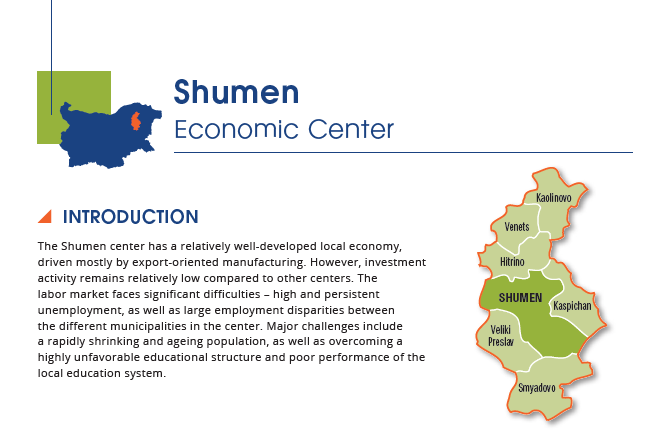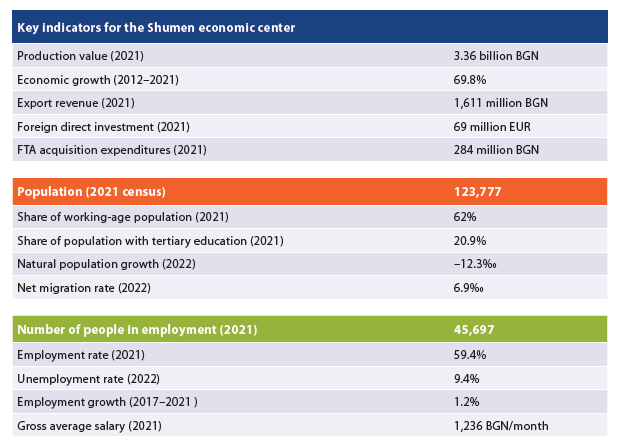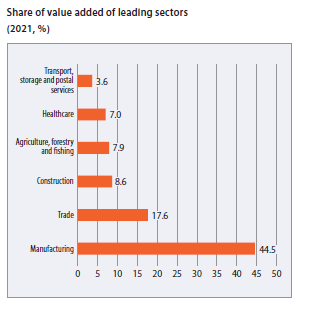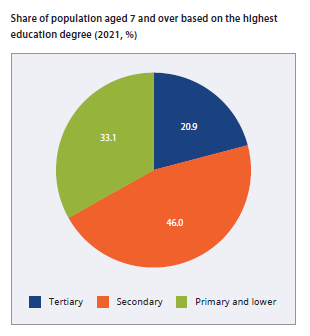Shumen Economic Centre
SHUMEN ECONOMIC CENTER
- INTRODUCTION | Key indicators for the Shumen economic center


COMPOSITION AND LABOR MIGRATION
The Shumen center consists of one core – the municipality of Shumen – and six peripheral municipalities – Hitrino, Venets, Veliki Preslav, Smiadovo, Kaspichan and Kaolinovo. Compared to the previous edition of the study (2017), two new municipalities – Kaspichan and Kaolinovo – are now included in the periphery, while two others are very close to the threshold for inclusion, with 9.4% of those employed in Novi Pazar and 9.3% of those in Nikola Kozlevo commuting daily to work in the core area, respectively. The municipality of Shumen attracts over 3,000 workers from its periphery, mostly from Veliki Preslav – 857, while jobs in the core are of the highest significance to Hitrino and Venets, where 38% and 33% of all employees commute to their jobs in the municipality of Shumen every day, respectively.
- ECONOMY AND INVESTMENT
 In 2021, the total production value in the Shumen center was 3.36 billion BGN or 27,200 BGN per capita, which is close to the national average. The growth of the local economy has been relatively moderate, with a 70% increase in value added compared to 2012. The concentration of economic activity is relatively high: 83% of the total value added is generated in the core, 6.4% – in Kaspichan, and 3.3% in Veliki Preslav. In terms of sectoral distribution, manufacturing is the most important economic activity – 45% of the value added, followed by trade (18%), construction (8.6%), agriculture (7.9%) and healthcare (7%). In some of the smaller municipalities, especially in Hitrino and Venets, agriculture plays a leading role. The leading company in both revenue and employment, with 1,200 workers, is the aluminum producer Alkomet, and among the other large enterprises are Avtomagistrali Cherno More with almost 800 workers, Ficosota and the Tranchev retail chain with 700 each. The leading employer in the periphery is the ceramics manufacturer Roca Bulgaria with over 400 employees in Kaspichan.
In 2021, the total production value in the Shumen center was 3.36 billion BGN or 27,200 BGN per capita, which is close to the national average. The growth of the local economy has been relatively moderate, with a 70% increase in value added compared to 2012. The concentration of economic activity is relatively high: 83% of the total value added is generated in the core, 6.4% – in Kaspichan, and 3.3% in Veliki Preslav. In terms of sectoral distribution, manufacturing is the most important economic activity – 45% of the value added, followed by trade (18%), construction (8.6%), agriculture (7.9%) and healthcare (7%). In some of the smaller municipalities, especially in Hitrino and Venets, agriculture plays a leading role. The leading company in both revenue and employment, with 1,200 workers, is the aluminum producer Alkomet, and among the other large enterprises are Avtomagistrali Cherno More with almost 800 workers, Ficosota and the Tranchev retail chain with 700 each. The leading employer in the periphery is the ceramics manufacturer Roca Bulgaria with over 400 employees in Kaspichan.
According to NSI data, FDI stock at the end of 2021 in the whole center totaled 69 million EUR, but it should be borne in mind that data for peripheral municipalities are confidential, which means that the actual amount of foreign capital is larger. Investment activity is generally concentrated in the core of the economic center, with 79%, or 224 million BGN, of all FTA expenditures in 2021 in Shumen municipality and 5% in Kaspichan. The industries with the highest investment are manufacturing (114 million BGN), trade, transport and tourism (56 million BGN), and agriculture (47 million BGN).
Shumen’s economy is highly export-oriented, with 1.6 billion BGN in export revenues in 2021, or 13,300 BGN per capita. However, compared to the major economic centers, labor productivity remains relatively low, with a value added per employee of 16,500 BGN per year.
- LABOR MARKET
Despite the good performance of the local economy, the Shumen center retained a high unemployment rate in 2022 – 9.4% according to Employment Agency data, with the rate higher only in the Kozloduy center. There are very large differences between the individual municipalities in the center – while in the municipality of Shumen the unemployed are only 3.5% of the working-age population, in Kaolinovo their share exceeds 38%, and in Venets – 33%. Most of the unemployed in the smaller municipalities are permanently out of work, with 26% of the employable population registered in the labor offices for more than a year in Kaolinovo, compared to only 0.3% in the Shumen municipality. In some smaller municipalities, there is also a pronounced problem with youth unemployment. Similar disbalances can be observed in the employment rate – the average for the center according to the 2021 census is 59.4%, but ranges from 67% in Shumen municipality to only 34% in Kaolinovo and 41% in Venets. The majority of employees – 33,300 out of the 45,700 employed in the center – are concentrated in the core.
Over the past 5 years, the local labor market has been undergoing a minimal expansion, with the number of employees increasing by 1.2% compared to 2017. The sectorial structure of employment largely follows that of the center’s economy, with 42% of employees in manufacturing, 18% in commerce, and 9% in agriculture. Over the same period, average salaries increased by 52% to 1,236 BGN on average across the center’s economy. In the municipality of Shumen, salaries are relatively high in healthcare – 2,068 BGN on average per month, as well as in ICT with 1,597 BGN, and outside this municipality – in manufacturing in Kaspichan with an average monthly salary of 1,439 BGN.
- HUMAN RESOURCES AND WORKFORCE
 Over the last decade, the center has lost 16% of its population, reaching 123,800 people at the last census – a relatively moderate decline compared to many other parts of northern Bulgaria. However, ageing is noticeable – 25% of the total population is aged 65+, and replacement indicators confirm that this process is accelerating. At the same time, the share of people of working age is 62%, or 76,800 people, which is close to the national average. It is important to note that there are significant differences between the core and the periphery, with ageing more marked in smaller municipalities and there is a correspondingly lower share of working-age population.
Over the last decade, the center has lost 16% of its population, reaching 123,800 people at the last census – a relatively moderate decline compared to many other parts of northern Bulgaria. However, ageing is noticeable – 25% of the total population is aged 65+, and replacement indicators confirm that this process is accelerating. At the same time, the share of people of working age is 62%, or 76,800 people, which is close to the national average. It is important to note that there are significant differences between the core and the periphery, with ageing more marked in smaller municipalities and there is a correspondingly lower share of working-age population.
The Shumen center is one of the country’s areas which have proved attractive for internal migration, with a net migration rate of 6.9‰ in 2022. It is also important that immigrants are attracted not only to the core, but also to most small municipalities, most prominently Hitrino (32‰) and Kaolinovo (16‰). The decline in population is mostly a consequence of low natural growth: –12.3‰ on average in the center, but up to –20‰ in smaller municipalities.
A serious obstacle to the future development of the center and to attracting investment is the educational structure of the population. Only 21% of people aged 7 and above have a university degree, while as many as 33.1% have a primary education or less; illiteracy is 1.1%. The educational profile is even less favorable in the periphery where the share of people with primary education and below exceeds 60% in some municipalities, and illiteracy reaches 3%. Against this backdrop, student performance is particularly poor, with the center having the lowest average score on the state matriculation examination in BLL among all 16 centers – Average 3.34 – and some of the lowest average scores on the external assessment after grade 7.
Latest news
REGIONAL AWARDS: Who is the most of the most among the regions 14.12.2025
For more than a decade, the Institute for Market Economics has been presenting the publication "Regional...
It's not just Sofia: where are the highest incomes and investments in the country 01.12.2025
In this year's edition of the IME study "Regional Profiles: Indicators of Development " 2025, the capital...
